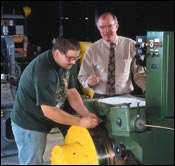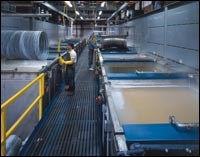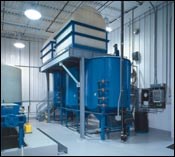Profile of a Pretreatment System
Profiles, Inc., moved to a new facility, installed a new cleaning line and doubled its capacity. The new line also gave the company greater flexibility when choosing a custom coating based on surface preparation or other variables...
Simple wire shapes are cold-rolled and drawn. For intricate, precision shapes, however, machining or the use of powdered metal is the expected manufacturing method. Such is the common wisdom. The uncommon wisdom is that precision die making techniques and controls, along with the willingness to think differently about how to achieve a given result, can produce intricate parts with exceptional consistency-and that this can be achieved at substantially less cost.
Profiles, Inc. (Palmer, MA) precision draws steel and stainless steel, as well as some non-ferrous metals. The company, now in its 25th year, is best known for its work with medium- and high-carbon steels, including M50 and 52100 bearing grade alloys. It also provides cleaning and finishing of many of the parts it produces.
Some of the world's largest manufacturers of vehicles, medical equipment, recreational goods and MRO products, such as pumps and power generators, outsource parts to Profiles. Sometimes these are small quantities; more often they are million-plus runs. The reasons include cost savings, faster turnarounds than would be possible with machined parts and high quality requirements. Profiles specializes in the manufacture of parts with tight dimensional tolerances and stringent finish requirements.
According to the company's president, Bob Brock, the key is expert carbide die making and engineering teams that are encouraged to think differently. "Our greatest challenge in the marketplace is purchasing agents who cannot get out of the box and think creatively," said Mr. Brock. "For any alternative to be workable, development engineers have to communicate directly with customers' engineers and essentially say, 'Look, there may be a more effective way to get the results you are looking for. Here is something to consider.'"
When consideration is given, results can be dramatic. One example is a component used in advanced microsurgery. This highly intricate, triangular part allows the surgeon to simultaneously cut, remove tissue and suture. It formerly cost the OEM $200 per piece to machine due to 4 hr of wire EDM work. By implementing minor changes to the prints, changes that did not affect metallurgy, dimensions or product performance, Profiles was able to draw the product as a shape, effectively creating a near-new product and rendering unnecessary any additional machining operations. The savings was 99%. The unit now costs $2.00. The surgical instrument company is currently negotiating with Profiles to finish manufactured products, in addition to components.
Featured Content
One of the nation's most recognizable manufacturers of hand tools approached Profiles with a component similar in shape to an I-beam. "We engineered a prototype, and they added requirements for cutting, hole-punching, heat treatment and zinc plating for corrosion protection. We took several of these outsourced processes and found we could offer advantageous pricing along with vastly simplified logistics," said Mr. Brock.
Profiles was able to provide all of these services in one shop after its move to a new facility in 2000, where a state-of-the-art pickling house was engineered, built and installed by M.E. Baker Co. The system consists of two parallel lines for cleaning and coating. The new 1,700-gal process tanks allowed the company to effectively double its single load capacity. To help facilitate drawing of its highly intricate shapes, Profiles selected an integrated chemical system engineered and supplied by Heatbath Corp.
The new pickling line consists of 28 tanks. The line configuration gives the company unlimited flexibility in choosing a custom coating based on surface preparation, coating and drawing requirements for incoming material. Pretreatment chemistries in the lines consist of alkaline cleaners, scale conditioners and inhibited acids, any combination of which may be used to remove oils, oxides and scale prior to coating.
Oxylate coatings are then used for stainless steel, while nitrite accelerated phosphate coatings enhance the retention of lubricants, which facilitate cold drawings. Finally, a reactive stearate lubricant combined with a specifically chosen draw box lubricant will prevent seizing and galling of the base metal when drawn and will significantly increase die life.
Profiles also incorporated several supplementary steps into its new lines. The use of a conditioner prior to phosphating nucleates a uniform, fine-grained phosphate crystal, which will not scratch dies. Neutralizing steps are also included to provide added corrosion protection to the work and achieve extended bath life of the stearate lube.
Rinse tanks are abundant in the new lines. Using a dunk rinse followed by a fresh water spray between each processing tank virtually eliminates cross contamination, greatly extending bath life, decreasing maintenance downtime, reducing chemical and waste treatment costs and most importantly, improving the overall quality and performance of the coatings.
Profiles has also installed a new semi-automated waste treatment system. The three-stage batch treatment system incorporates pH neutralization, polymer additions and filtration. The system was designed for simplicity of operation and can easily handle the volumes of wastewater generated.
The operation of Profiles' cleaning house, from titration of tanks to temperature controls as well as all other design and manufacturing processes, is well defined within its ISO 9001 parameters. Profiles achieved ISO certification in 1997.
Mr. Brock believes the company's competitive advantage comes from its ability to act quickly and with agility. "Our organization is flat. Our engineering teams are knowledgeable and creative. Our key suppliers function like partners when we need to work together on a customer's problem. These attributes are particularly beneficial when you need to redraw customers' prints and give them a workable alternative for getting the required results.
"Design for manufacturing is a big deal," he continued, "and good design becomes good engineering. Recently, we began supplying a new customer with wire for use in commutators. When we quoted the job, the former supplier's reject rate was 50% based on tolerance. We developed prints drawn to their specifications, and the rejections dropped to zero.
"Sometimes," he continued, "these changes happen in midstream such as when a customer's design-in product changes. We are setup to make tooling modifications within hours. It is that flat organization at work again. We design die geometry to situations. Our claim to fame is approaches that produce parts that are as repeatable on the second pound of material as they are a million pounds after that.
"Cold-drawing and rolling is known, but not well understood," concluded Mr. Brock, "at least not in terms of what is possible today. Powdered metal and rows of machining operations are still what most product people think of first. What is worth knowing is that there are proven, repeatable, cost effective and fast ways to produce intricate shapes-from dental brackets to ventilator plates for power generators. The key is in the die and what people know. Because producing this way, persuading material to flow consistently and with precision, in a certain way and in a specific direction, is an art form. You cannot buy machines to do it. It is all in the design, the die, the lubricant and the finishing chemistry.
To learn more visit Heatbath Corp..























